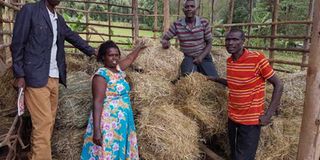Smallholder farmers in Bomet turn hay production into profitable business

Some members of Shirikisho Community Development Group, which brings together smallholder farmers from Kaparuso Village in Bomet County who produce commercial hay. Each member gets a profit of at least Sh60,000 a year. PHOTO | RACHEL KIBUI | NATION MEDIA GROUP
What you need to know:
- They are part of close to 7,000 smallholder dairy farmers who have benefited from the KAVES project.
- KAVES dairy department aims at increasing incomes of small-scale dairy farmers.
- The group harvests between 180-200 bales of hay per acre, which they sell at Sh300 each.
- On average, each of them gets at least Sh60,000 per year in profits.
It is mid-morning at Kaparuso Village in Bomet County.
A group of five people have met at a home.
Vividly visible here is an open-walled store with several bales of hay.
One could easily mistake the owner of this home for a large-scale hay or dairy farmer.
But the bales belong to Shirikisho Community Development Group whose 34 members are married couples, a man and his wife, but with independent membership.
On this day, some of the officials of this group have met to strategise on how they can meet the high demand of hay, occasioned by a prolonged dry period.
The group, which was formed four years ago, jointly cultivates 10 acres of Boma Rhodes grass which they bale to hay and sell.
“We formed the group after sensitisation on the need to play a business-oriented role in the dairy sector as hay producers and sellers,” says Sammy Kirui, the group’s chairman.
7,000 BENEFICIARIES
They are part of close to 7,000 smallholder dairy farmers who have benefited from the Kenya Agricultural Value Chain Enterprises Project (KAVES).
Funded by USAID, KAVES dairy department aims at increasing incomes of small-scale dairy farmers and boosting value addition and product diversification.
Initially, the 34 members of the group were just 17 couples in the same neighbourhood.
Each one of them, Kirui says, would struggle to earn money from small-scale dairy farming.
But, none of them had ever thought of an alternative way of making money while still maintaining small-scale farming in the same sector.
ONE ACRE EACH FOR HAY
With most of the couples owning an average of between 2-4 acres of land, they still set aside a minimum of one-acre portion for hay production.
“From our farms’ production, members are free to either sell (the through the group or spare for their own livestock,” says Kirui.
From one acre, the group harvests between 180-200 bales of hay, which they sell at Sh300 each.
There is no special price for members though, and they have to purchase it at the same price as non-members.
Besides local livestock farmers, the group has clients in other counties including Narok, Kisii and Nakuru.
Their main way of marketing is through word of mouth and referrals from older clients.
Profits from hay sales is shared equally among members.
SH60,000 ANNUAL PROFIT
On average, each of them gets at least Sh60,000 per year in profits.
“We have a rule that each man and woman gets his or her money independently and not as a couple,” says Kirui.
Initially, he adds, men would oppress women by taking the lion’s share of the profits.
Besides solving the animal feeds puzzle in the area, the group also employs its own members and youths as casual labourers.
For them, this venture is part of job creation for the village and a way of bringing them together.
Zeddy Kinduyu, a member of Shirikisho group says she has not only gotten a chance to interact with neighbours, but has also improved the livelihood of her family.
“At least I am assured of a source of feeds for my four dairy cows as well as a source of income,” she says.
TABLE BANKING
The group also has a table banking department through which they lend soft loans to members at a monthly interest of 10 per cent.
USAID-KAVES Technical advisor in charge of dairy farming, Joyce Mutua, says Kenya is often faced with milk shortage especially in dry seasons due to fodder shortage.
“It is in this view that KAVES has been promoting hay production in 22 counties across the country,” says Mutua.
Under this project, she adds, over 38,000 acres of fodder have been produced thus increasing milk production throughout the year.
Counties covered by this project include Kericho, Kisii, Nyamira, Kisumu and Embu.
Like any other venture, hay production by Shirikisho group comes with its challenges.
Production is sometimes negatively affected by prolonged dry periods.
Sometimes, the bailing machine develops mechanical problems yet manual bailing is not only tiresome, time consuming but also costly.





